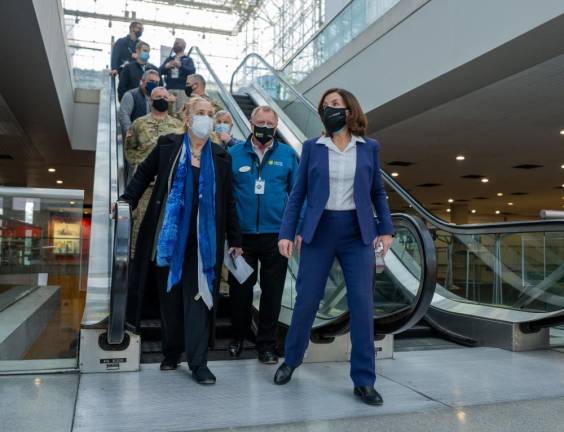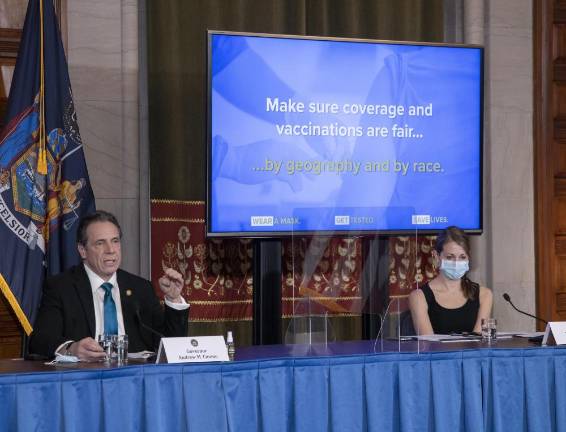There are two types of New Yorkers. Those waiting to be eligible for their COVID-19 vaccine and the other 4.5 million adults who have already been declared eligible and, willingly or not, have been plunged into a public health version of “The Hunger Games.”
The number of New Yorkers told they are eligible has wildly outrun any improvement in supply as Governor Andrew Cuomo pushed from a tightly limited cadre of medical workers in December to, now, everyone over 65, anyone under 65 with medical conditions that exacerbate COVID-19, frontline public servants and essential workers including, as of last week, taxi drivers and restaurant staff.
“The frustration level is so huge,” reported Manhattan Borough President Gale Brewer.
The situation is so out of whack that more than one observer expressed suspicion that Cuomo had a Machiavellian motive (believe it or not) to create so much demand that the Biden administration would have no choice but to allocate more vaccine to New York.
While this thesis would be in character for Cuomo, it is just as likely that the political clamor for eligibility is so intense that it is easier for the governor to say yes and let local officials deliver the message of, “Well, actually, no, not yet.”
For many seniors the face of this scarcity is simply opaque and complex websites that offer vaccine appointments the way Vegas slot machines produce triple cherries. You might as well try, but who can tell who the winners will be or why.
“We have been trying to help people register and the only appointments we can find are in April in Rochester,” Nina Schwalbe, an adjunct assistant professor at the Mailman School of Public Health at Columbia, told a city official a couple of weeks ago.
Brewer says she and her staff have spent hours on the phone trying to help constituents navigate the tangle of city, state and hospital websites and phone numbers that offer the hope of a vaccine appointment.
“It drove me crazy,” said Brewer. “I don’t know how older people do it. It was awful.”
Pop-Up Vaccine Site
Behind this aggravation a whole second level of resentments are bubbling over among community organizations that took at face value the call to help distribute vaccine to the most vulnerable.
Christopher Marte, a Lower East Side community organizer and candidate for City Council, said he had been working with Schwalbe and with Joanna Samuels of the Educational Alliance, a not-for-profit, to create a pop-up vaccine site to serve low-income seniors in a 5,000 square-foot space in the Alliance’s Manny Cantor Center at 197 East Broadway.
Their plan was submitted more than a month ago, Marte said. But even though the proposal was in direct response to a city request for exactly that sort of facility, Marte and his colleagues have been repeatedly told to wait.
Schwalbe has been emailing with city officials for more than a month in support of the proposal. “They seem incredibly frustrated with the State,” Schwalbe related. “It is Cuomo that expanded eligibility – the CITY has to play catch up.”
“We appreciate the support and enthusiasm!” a city official told Schwalbe in early February. “As you noted, there is limited vaccine availability. To stand up new sites and offer more appointments, we will need additional doses of the vaccine from the federal government.”
When the governor announced a mass vaccination site to serve the Bronx, Schwalbe wrote to city officials hoping to re-energize interest in the neighborhood approach the city itself had proposed:
“Is there any way to get a message to the Governor that while Yankee Stadium may help some,” Schwalbe asked the city official, “what we really need are community sites close to where people actually live, in particular seniors?”
“Thanks, Nina,” the official said later. “Supply continues to be our biggest constraint, especially in light of the snowstorms across the country! We have seen some expansions through State/FEMA partnerships and the federal pharmacy program, but there’s more that’s needed to expand into the infrastructure we would set up if we had more doses. We’re hopeful the Biden Administration will respond to our calls for additional allocation to expand access even further.”
“Infrastructure in Place”
The email included a link to Mayor Bill de Blasio’s statement of last week: “I cannot be clearer: we have the infrastructure in place to deliver half a million doses per week. All that’s missing is the supply to get it done. We need the pharmaceutical companies to step-up and give us the doses we need to vaccinate the people of our city. There is not a moment to waste.”
Schwalbe, an expert in public health and vaccine distribution, said the rapid eligibility expansion would make sense if the principal strategy was to stop the spread by getting vaccine in as many arms as possible as quickly as possible. But since the clinical trials were designed to demonstrate that the vaccines stopped the disease, COVID-19, not the spread of the virus, the logical approach is to concentrate on the most vulnerable first.
The rationing has lost its rationale, Schwalbe argues. “They expanded the categories too fast – and can’t walk that back.”
There has been some preliminary evidence that the vaccines do reduce spread of the virus, in addition to curbing serious illness. In fact, a faculty member at Johns Hopkins, Marty Makary, wrote this week in the Wall Street Journal that he expected herd immunity in the United States by April through the combination of vaccination and widespread exposure to the virus.
We probably will not know if he is correct until it happens, or does not. In the meantime, Schwalbe said, “we are losing community members by the day.”
The competition set off by the expansion of eligibility has clearly, so far, worked to the advantage of residents of higher income neighborhoods, presumably because they have better access to both the internet and the medical system. Some neighborhoods with large numbers of frontline city workers, who have been eligible for some time, also have high vaccination rates.
Indeed, one city official, Torian Easterling, the first deputy health commissioner, made the case last week that the latest eligibility expansion, to those under 65 with COVID-19 comorbidities, was a way to counter inequities that developed during the early weeks of vaccination when eligibility was narrower.
Because preexisting conditions are more prevalent in low-income and communities of color that have suffered “longstanding health inequities,” adding the preexisting conditions to vaccine eligibility will allow the city to assure, Dr. Easterling said, “that we are getting to our seniors, but also making sure that we’re getting to individuals with high rates of underlying chronic conditions.”
“The frustration level is so huge.” Manhattan Borough President Gale Brewer

